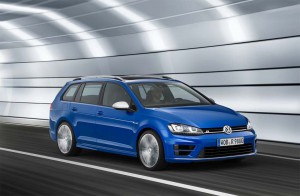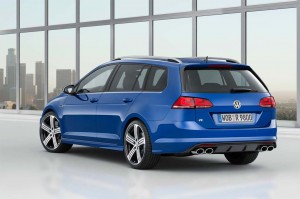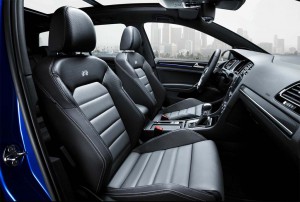
Volkswagen's Golf R wagon is expected to go on sale next year in Europe, but U.S. fans will be left in the cold...for now.
There’s a certain level of cruelty in Volkswagen’s decision to debut the new Golf R “Variant” at the Los Angeles Auto Show this week. It’s like teasing a dog with a bone, or holding a jar of candy just out of a child’s reach. You see, VW is confirming this will be the first-ever wagon version of the new Golf R but, for the moment, it will only confirm plans to put the new model on sale in Europe, starting next spring.
There’s certainly a lot to like about the Golf R wagon, starting with its 296-horsepower 2.0-liter TSI engine. That’s more than enough to launch from 0 to 100 kmh (0 to 62.5 mph) in 5.1 seconds, on the way to an electronically limited 155 mph top speed.
By comparison, that’s off a modest 0.2 seconds from the shorter, lighter hatch version of the Golf R. It helps that the Golf R wagon uses a six-speed DSG linked to a performance-tuned 4Motion Haldex all-wheel-drive system to ensure the maximum amount of power goes to the pavement. The new XDS+ electronic locking differential system adds torque vectoring to improve cornering.
Visually, the Volkswagen Golf R wagon gets treatment similar to that of the R hatchback. That includes unique R-style front bumpers and air intakes, a sportier grille with LED running lights and Xenon headlamps, quad exhaust pipes and aero detailing by the back, or D-, pillar.

The Golf R wagon gets a similar package as the R hatchback with Xenon headlamps, quad exhaust pipes and aero detailing in the back.
The interior also gets some nice updates, including the availability of optional Alcantara and leather-trimmed sport seats and carbon trim on the dashboard, with a leather-wrapped R steering wheel completing the package.
The wagon also adds a significant amount of storage capacity over the hatch – though it boosts the overall weight of the model by about 200 pounds.
(VW offering two extreme Golf concepts at L.A. Auto Show. For more, Click Here.)
VW tries to amp up the performance fun factor with progressive variable-ratio electric power steering. And it features an ESC Sport mode that allows the driver to raise the threshold before the electronic stability control system kicks in. ESC can also be disabled entirely for track use.
(Click Here for the report on the Golf being named Motor Trend’s 2015 Car of the Year.)

The Golf R wagon, when ordered with the DCC adaptive damping system, allows a driver to switch between five different modes, from Eco to Race.
The normally optional Driving Profile Selector becomes standard on the Golf R wagon when ordered with the DCC adaptive damping system. It allows a driver to switch between five different modes, from Eco to Race.
(To see what Bentley’s “Grand” plans are for Los Angeles, Click Here.)
But all this still begs the question: what about us in the U.S.? The new Volkswagen Golf R wagon is a natural for the European market, where so-called “two-box” designs are extremely popular. Not so in the States, where wagons have struggled for years to win over buyer attention.
That said, the choice of Los Angeles, rather than last month’s Paris Motor Show, seems to provide an enormous hint – as does VW’s steady drumbeat for the Golf R wagon’s debut. Chances are, the maker is going to watch the public reaction at the Tinseltown show before giving us kids our candy.

Volkswagen just keeps doing it. I would be driving a Golf R today, but while it has been available for some time in Europe, it won’t be in the U.S. until some time in 2015. Ditto the performance version of the new generation GTI. Still no 2 doors in the U.S., either. VW, keep treating us like we’re not an important market, and you’ll lose customers. You’ve lost me.
The issue with any of the special models being brought to the U.S. is cost vs. sales volume. The “R” models in general while very cool, sell in low volume because VW’s U.S. sales are quite low and the sticker price is generally too high for many younger folks who can buy a Subaru AWD or similar for less money. Some may argue that the Subaru is not as sophisticated as the VW R but it’s popular with the younger crowd.
VW has even had issues selling just 5,000 units of the R32 models in the U.S. when available in 2004 and 2008. The last ~2500 units were heavily discounted to move them in the next model year. In addition the dealers aren’t thrilled with many of these R models where the margins are very thin because of the cost to VW U.S. to bring these low volume, U.S. spec cars into the U.S.
If VW U.S. could get it’s annual sales up in the 400K units range, then they’d be able to justify bringing in more of the special models sold in Europe.